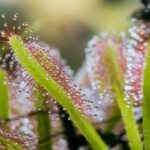As an Amazon Associate, this site earns commissions from qualifying purchases. For more details, click here.
Dormancy is one of the most complex areas of plant care, and knowing as much as you can is important. This is particularly true for sundews. While most sundews do not go dormant in winter, some species do. So you have to know how to care for the plant if your variant requires dormancy.
Tropical sundews like the Spoon Leaf do not go into dormancy, but with temperate sundews it will depend on the variant. Cape Sundews do not require dormancy for example, but other temperate sundews do.
Which Sundews Go Dormant?
Most sundews do not need dormancy which is what makes them easier to grow than other plants. However there are some variants that would benefit from this.
The easiest way to find out if your sundew requires dormancy is to check the instructions that came with your plant. When you buy a sundew it will contain information on how to grow, feed and care for the plant, including dormancy.
The rule of thumb is that sundew dormancy requirements depend on its region. If it grows in the tropics, no dormancy is needed. If the plant is an arctic or winter type, then dormancy is needed. If it is a temperate specie, it depends on the plant.
Gere are some popular drosera species and their dormancy requirements;
- Tropical sundews like King Drosera, Alice Sundew, Spoon Leaf and Forked Sundews do not go dormant. They grow the whole year regardless of the time. These sundews might go dormant if the temperature drops below freezing, but it is not needed. These are the best carnivorous plants for beginners and need little maintenance. You can grow these plants outdoors or in an Elegant Life Terrarium.
- Temperate sundews grow in colder locations than their tropical variants. However that does not mean they require dormancy. Cape sundews and Round Leaf Sundews do not. But some species do so you have to check the guidelines that came with your plant.
- Winter weather sundews like D. indumenta and D. aberrans require full dormancy. Just like with temperate sundews, the duration and period varies among variants.
What has been noted above are some of the most well known drosera species. There are many more and if yours is not listed, you need to research its dormancy needs.
It is important to do the research before you buy the plant. Being prepared and knowing what to expect makes caring for sundews easier for you in the long run. This is going to make it easier to care for the plant especially if you are a beginner.
How to Care For Sundews in Winter
Sundews that go dormant do not need additional cost. However there are specific steps that you have to take. The following are applicable to almost any dormant sundews.
Know the signs of dormancy. Indications include shrinking, falling leaves, dew drying up, refusal to eat etc. These are normal and should be expected. When the plant comes out of hibernation it will start growing leaves and dew again. If the plant is not yet strong enough to catch bugs, you can give it a few bits of South Shore Tropical Fish Flakes.
Bring the plant indoor if necessary. If necessary is a relative term. Dormant sundews can handle regular winter temperature. But if it is colder than usual – and lasts longer – cover the plant or bring it indoors.
If you do bring a sundew inside, make sure it is kept in cold storage otherwise it will emerge early from dormancy. Sundews cannot survive temperatures under 20 F (-6 ). If your drosera is outdoors, keep a watch on the temperature to make sure it is not too cold.
Mulching. If the weather gets really cold, mulching will be needed. How much depends on the plant and what kind of temperature you are experiencing.
Reduce soil moisture. Sundews in dormancy need less water so minimize soil moisture. Do not let the soil go dry. At room temperature, dormant sundews will do fine with less water. Once they emerge from dormancy you can increase soil moisture again. Use distilled, purified or reverse osmosis water.
Never let temperate sundews freeze in their pot. If the temperature goes below 20 F, provide cover as suggested above or bring the pot indoors. A greenhouse can also offer protection for sundews and other plants.
Check which plant hardiness zone you are in. Most sundews grow in zones 7 and 8, but others can deal with lower zones provided they are cared for. There are also some sundews that thrive in zone 9 like D. brevifollia and D capillaris.
Is My Sundew Dormant or Dead?
This is one of the most common questions that new drosera owners ask, and it is understandable. Dormancy has many of the same signs as a dying sundew plant, so how can you tell the difference?
A dormant sundew differs from a dying sundew in the following ways:
- The crowns are still visible
- Some sundews bloom one last time before going into dormancy
- Tropical sundews do not become dormant. If yours does it means the plant is sick or dying.
- Even dormant plants will have bits of greens or leftover leaves. These are very small but if you look closely you will see them.
- Dormant sundews have firm stems. A mushy stem means the roots are not healthy.
- Dormant sundews eventually grow back to its original form as winter comes to an end. This might take a while but it will occur. A dying plant will not be revived even at springtime.
- If your sundews have no dew and think it has nothing to do with dormancy, the plant could be lacking sunlight.
It is normal for dormant sundew leaves to turn brown and fall off. This is also a sign of root rot and bacterial infection though. If you see brown leaves, observe the sundew first. If this occurs during winter, it could simply be dormancy. Check for other signs of life as indicated above.
What Else Do I Need to Know about Dormancy?
It all comes down to what type of sundew you want to buy and your location. If you live in a tropical climate and buy tropical sundews, you do not have to worry about dormancy. If you live in a temperate region, simply follow the guidelines here and those that came with your plant.
If you do not want to deal with dormancy, get a tropical or temperate sundew that does not go into dormancy like Cape Sundews. As long as you live in a tropical location you can leave the plant outdoors. Make sure it receives plenty of light, water and insect food or mealworms.
If your sundews go dormant, remember that this can start as early as the fall. You will notice signs from the plant such as dropping leaves etc. This is nothing to worry about.
Once your sundews emerge from dormancy, give it time to get settled. If you kept it outdoors under cover, remove the cover and expose it to light a few hours a day. Increase the exposure slowly over several days.
When the sundew starts producing dew again, it should be able to catch bugs. If there are not many in your area, give it food. Do not overfeed the plant, just 1 to 4 times a month is fine. But if the traps already catch bugs, do not hand feed it anymore.
If your sundews take too long to emerge from dormancy, check for signs of life. Are the stems firm? Do you see any leaves growing? How is it coming along compared to your other sundews (if you have more than one)?
Above all you need to be patient. It takes time for a drosera to come back from dormancy so do not rush it. When it does, you will see the plant again in full bloom.
Conclusion
One of the reasons why sundews are popular is most of them do not go into dormancy. This hibernation period requires some care and it might seem daunting for new growers. If your sundews do not need dormancy, that is great. If it does, hopefully the information here was able to help.

My fascination with carnivorous plants began many, many years ago with Venus Fly Traps. Now I am more than happy to impart what I know with other enthusiasts and those who are curious about meat eating plants.



